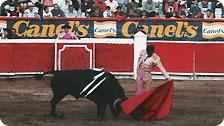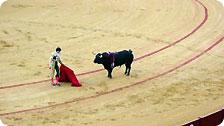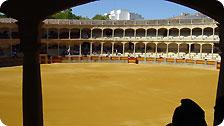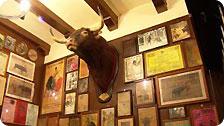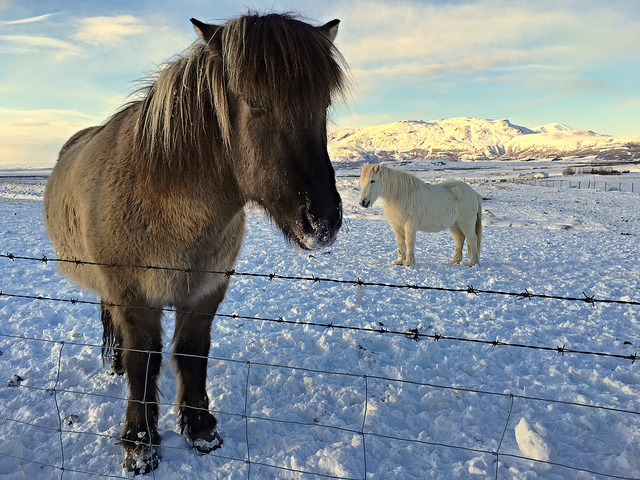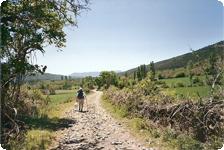Culture: Spain: Bullfight in Madrid
by Mary O’Regan
The stadium smelled of salty peanuts and old man cigars. There were three
flags flying high above the seats with Spain’s in the center position. We
walked up steep, narrow steps and sat on hard concrete rows; our seats were
in the lower deck near the doors through which they release the bulls. The
crowd was excited and anxious for the action to start, with few people up
and walking around.
The horns wailed, the doors flew open and a bull came charging out.
Immediately the crowd erupted in cheers and applause as the bull tore around
the ring, slamming his horns into the wall, kicking up dirt and looking for
something to demolish. Three banderilleros appeared with magenta capes and
matching socks pulled high up over their tight, white pants. They teased
and taunted the bull, stomping their feet and jerking their capes.
Freshly
stabbed and angry, the bull raged at them with unstoppable energy and
deadly, brute strength. His tail flicked back and forth eagerly as he flew
through waving capes, head low to the ground, horns white and sharp.
The picador entered carrying a giant lance and riding a blindfolded horse
with heavy padding draped over its body. He waited with his lance held high
as the banderilleros provoked the bull, causing him to charge the horse.
Screams of delight sounded throughout the stadium as the bull thrust his
horn into the padded belly of the horse and the picador stuck his lance deep
into the bull’s shoulder. Using their capes, the banderilleros diverted the
bull away from the horse and continued to run him around the ring as blood
ran down his back.
This was only the beginning of the bull’s slow, merciless death. Two of the
banderilleros threw aside their capes and picked up sharp, harpoon-like
banderillas, while the third banderillero enticed the bull into position.
He charged forward angrily and the banderillero stabbed his neck with the
banderillas; they stayed stuck in him like thumbtacks on a corkboard,
handles swinging on his back, bouncing up and down. Blood poured out his
wounds and covered his sides in thick maroon velvet. His tail stopped
wagging and he was noticeably slower in his attempts to chase the pink
capes.
Finally, it came time for the matador to showcase his talents. A mere
twenty-two years old and with the body of a ballerina, the matador moved
with a confident grace and faced the bull fearlessly. He pranced around the
ring with his chest puffed out and threw down his hat, ready for action.
The bull was tired, but not defeated. His enormous gut heaved and his head
bucked wildly as he twisted in pain. The banderillas beat against his side
and two of them came lose and fell to the ground.
The matador called to the bull, stomped his feet, and shook his red cape.
Infuriated, the bull charged at the cape and sailed under it as the matador
swiveled his hips to the side and let the bull pass. They continued this
dance back and forth across the ring with the matador occasionally turning
his back and walking away cockily as the bull searched for red satin.
The
crowd screamed, “Ole!” with each charge and exclaimed loudly at every close
encounter between the bull and the matador.
The bull grew slower. He had lost a lot of blood. The matador retrieved a
long, thin lance from the sidelines and prepared himself for the kill. He
held the cape off to the side and raised the lance straight out in front of
him, parallel with the bull’s spine. This was the most dangerous part of
the bullfight because it required going head-on with the bull and risking
being gored.
The bull charged and just as they were about to collide the matador plunged
his lance deep into the bull’s neck and let go. The banderilleros rushed
into the ring, capes flying wildly, dizzying the dying bull until he
collapsed on the ground, blood rushing from his nose and mouth. His body
heaved and he died.
Wild cheers erupted from the audience and everyone stood to honor the
matador, waving white handkerchiefs high above their heads in victory. The
matador strutted around the ring with his banderilleros at his side, holding
his hat out in front of him like a medal. In the background, a team of men
and horses tied up the dead bull and dragged him out of the ring by his
neck.
Areneros appeared and raked up the blood that covered the sand where
the bull took his last breath.
Ten minutes later, it started all over again with a new bull. And again and
again and again until eight bulls were killed and the people’s
bloody-thirsty appetites sated. Each time, the bull raced out into the ring
with fierce determination, as if he would be the one that finally makes it.
The one that finally outsmarts the whirling red capes and swift matador
moves.
But the bull never wins. They always die the exact same way, every
time, give or take a few liters of blood. They collapse under their own
weight and look like fallen tables when they land on their side with their
legs stuck straight out. It’s always the matador who gets to have the
victory walk and feel the adoration of the crowd and see the white hankies
waving.
But tradition is tradition for a reason and bull fights are part of
Spanish history, so I’m not going to muss that up with fairness and morals.
I feel lucky that I was able to experience such a cherished Spanish pastime,
especially on Easter afternoon, one of their most cherished holidays. It’s
just too bad for the bull. I doubt anybody wished him a Happy Easter before
sentencing him to die.
About the Author
Mary is a 24-year-old single Minnesotan woman who decided to quit her job,
ditch her apartment and travel across Europe with a few sets of clothing
and a burning desire to write. She loves the people she meets even more than
the places she see, and she has moments in which she want to run home and hide
under the covers. But everyday something happens that makes it all worth
it. Mary’s been bitten by the travel bug and wants to share her experiences
with the world.
Discover more from Tango Diva
Subscribe to get the latest posts sent to your email.
